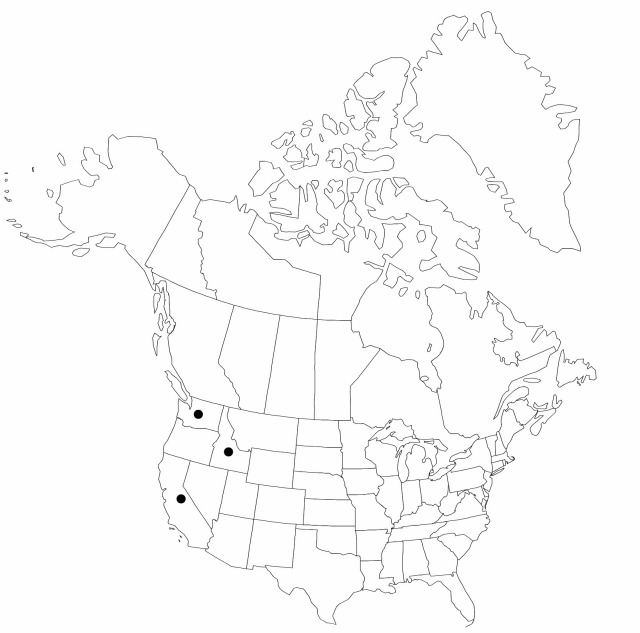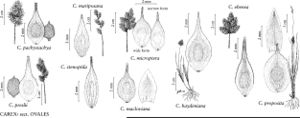Difference between revisions of "Carex proposita"
in N. L. Britton et al., N. Amer. Fl. 18: 126. 1931.
FNA>Volume Importer |
imported>Volume Importer |
||
| (4 intermediate revisions by 2 users not shown) | |||
| Line 1: | Line 1: | ||
{{Treatment/ID | {{Treatment/ID | ||
|accepted_name=Carex proposita | |accepted_name=Carex proposita | ||
| − | |accepted_authority=Mackenzie | + | |accepted_authority=Mackenzie |
|publications={{Treatment/Publication | |publications={{Treatment/Publication | ||
|title=in N. L. Britton et al., N. Amer. Fl. | |title=in N. L. Britton et al., N. Amer. Fl. | ||
|place=18: 126. 1931 | |place=18: 126. 1931 | ||
|year=1931 | |year=1931 | ||
| + | }} | ||
| + | |special_status={{Treatment/ID/Special_status | ||
| + | |code=F | ||
| + | |label=Illustrated | ||
| + | }}{{Treatment/ID/Special_status | ||
| + | |code=E | ||
| + | |label=Endemic | ||
}} | }} | ||
|basionyms= | |basionyms= | ||
| Line 31: | Line 38: | ||
-->{{#Taxon: | -->{{#Taxon: | ||
name=Carex proposita | name=Carex proposita | ||
| − | + | |authority=Mackenzie | |
| − | |authority=Mackenzie | ||
|rank=species | |rank=species | ||
|parent rank=section | |parent rank=section | ||
| Line 45: | Line 51: | ||
|publication title=in N. L. Britton et al., N. Amer. Fl. | |publication title=in N. L. Britton et al., N. Amer. Fl. | ||
|publication year=1931 | |publication year=1931 | ||
| − | |special status= | + | |special status=Illustrated;Endemic |
| − | |source xml=https:// | + | |source xml=https://bitbucket.org/aafc-mbb/fna-data-curation/src/2e0870ddd59836b60bcf96646a41e87ea5a5943a/coarse_grained_fna_xml/V23/V23_612.xml |
|genus=Carex | |genus=Carex | ||
|section=Carex sect. Ovales | |section=Carex sect. Ovales | ||
Latest revision as of 20:42, 5 November 2020
Plants densely cespitose. Culms 10–35 cm. Leaves: sheath adaxially white-hyaline, summits U-shaped; distal ligules 0.9–2 mm; blades 2–4(–5) per fertile culm, occasionally folded, 6–20 cm × (0.5–)1–2(–2.5) mm, if not folded, margins revolute. Inflorescences dense or open, gold to dark brown, 1.7–3 cm × 11–18 mm; proximal internode 4–8.6 mm; 2d internode 1.5–3.5 mm; proximal bracts usually scalelike or bristlelike, occasionally leaflike, shorter than inflorescences. Spikes 3–6, distant to loosely aggregated, distinct or individually indistinct, broadly ovoid, 10–15 × 7–9 mm, base acute to attenuate, apex rounded. Pistillate scales gold or reddish to dark brown, with pale midstripe, lanceolate to ovate, 3.5–4.8 mm, usually shorter than and 1/3–1/2 width of perigynia, margin white, 0–0.2 mm wide, apex obtuse to acuminate. Anthers long-persistent. Perigynia ascending to spreading, gold to coppery; conspicuously 3–11-veined abaxially, conspicuously 0–13-veined adaxially, broadly ovate, usually flat, 4.3–6.3 × 2–3 mm, 0.25–0.5 mm thick, margin flat, including wing 0.4–0.9 mm wide, edge often minutely crinkled; beak red-brown or brown, usually white-hyaline at tip, cylindric, unwinged, ± entire for (0.3–)0.5–0.9 mm, ciliate-serrulate at least on distal body, abaxial suture inconspicuous or with conspicuous white margin, distance from beak tip to achene (1.9–)2.2–3.7 mm. Achenes elliptic, 1.5–2.1 × 0.75–1.1(–1.3) mm, 0.25–0.5 mm thick.
Phenology: Fruiting summer.
Habitat: Montane and rocky places
Elevation: 2400–4100 m
Distribution

Calif., Idaho, Wash.
Discussion
Selected References
None.
